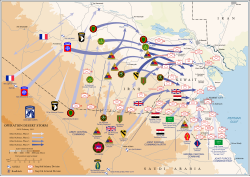| Outline of war |
|---|
Third generation warfare is a term created by the U.S. military in 1989, referring to the tactics of warfare used after the Wehrmacht's development of the blitzkrieg.[1] Third generation war focuses on using speed and surprise to bypass the enemy's lines and collapse their forces from the rear. Essentially, this was the end of linear warfare on a tactical level, with units seeking not simply to meet each other face to face but to outmaneuver each other to gain the greatest advantage.
History[]

Fast advances and maneuvering allowed Allied cavalry forces to quickly penetrate deep into Iraq during the Gulf War
The use of blitzkrieg during the German invasion of France first demonstrated the power of speed and maneuverability over static artillery positions and trench defenses. Through the use of tanks, mechanized infantry, and close air support, the Germans were able to quickly break through linear defenses and capture the rear. The emphasis on maneuvering and speed to bypass enemy engagement remains a common strategy throughout the world, and collapsing an enemy's defenses by striking at deeper targets is — in a somewhat different way — a major strategy in fourth generation warfare.[2]
Contributions to warfare[]
The contributions of the third generation were based on the concept of overcoming technological disadvantage through the use of clever strategy. As linear fighting came to an end, new ways of moving faster began to appear. The emphasis on cavalry moved from heavy armor to greater speed, the development of the helicopter allowed insertions in hostile territory, and advanced missile technology allowed forces to bypass enemy defenses and strike at targets from great distances. The speed inherent in these methods necessitated a greater degree of independence allowed to the units on the front lines. Greater trust needed to be placed in junior officers commanding sub-units by higher-ranking officers - a belief that they could adequately achieve their objectives without micromanagement from higher ranking commanders in command headquarters.
Smaller units were allowed greater decision flexibility to deal with changing situations on the ground, rather than have decisions made for them by commanders who were distant from the front. This began to break down the regimented culture of order that was so important in previous theoretical eras of military command and control.
Examples[]
See also[]
References[]
- ↑ Lind, William S.;Nightingale, Keith;Schmitt, John F.; Sutton, Joseph W.;Wilson, Gary I. (1989). The Changing Face of War: Into the Fourth Generation.
- ↑ Lind, William S. (2004). "Understanding Fourth Generation War". http://antiwar.com/lind/index.php?articleid=1702.
The original article can be found at Third-generation warfare and the edit history here.